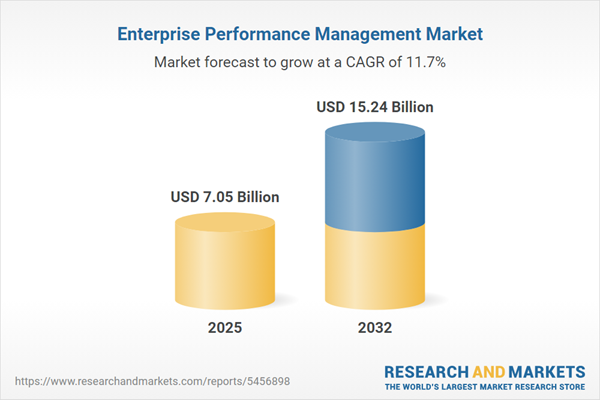Speak directly to the analyst to clarify any post sales queries you may have.
Enterprise performance management (EPM) is transforming decision-making by bringing strategy, finance, and operations together into a unified framework. With rising demand for agile, data-driven processes, organizations are turning to EPM solutions to achieve operational clarity, improve compliance, and maintain continuity in an evolving business landscape.
Market Snapshot: Enterprise Performance Management Market Size and Growth
The global enterprise performance management market is witnessing significant advancement, driven by the urgent need for integrated, analytics-based decision support tools. Accelerating digital transformation efforts are pushing organizations toward improved transparency and operational agility. Businesses from diverse industries and geographies are embracing EPM platforms to keep pace with shifting regulations and the growing call for process unification. Top enterprises are leveraging EPM to simplify compliance tasks and promote resilience, highlighting the expanding importance of these solutions for executive teams.
Scope & Segmentation of Enterprise Performance Management Solutions
- Components: EPM comprises robust software suites available via flexible licensing or subscription, plus managed services that ensure successful integration, continued technical support, and lasting process optimization.
- Deployment Modes: Organizations select between cloud-based EPM—enabling scalable, adaptable workflows—or on-premises deployments, suitable for firms with strict oversight and regulatory mandates.
- Applications: Key uses of EPM include budgeting, forecasting, advanced analytics, strategic planning, regulatory reporting, and the management of financial close, all designed to offer high transparency and data-driven governance.
- Organization Sizes: EPM solutions cater to global corporations, mid-size enterprises, and small businesses, ensuring operational benefits evolve in line with organizational growth requirements.
- Industries: Adoption is strong in financial services, insurance, banking, energy, government, healthcare, life sciences, IT, telecom, manufacturing, and retail, as businesses invest in EPM to streamline regulatory processes and drive digital modernization.
- Regional Coverage: Market characteristics vary internationally, shaped by digital maturity, compliance obligations, and infrastructure capabilities across the Americas, Europe, Middle East, Africa, and Asia-Pacific regions.
- Key Vendors: Established providers—such as Oracle Corporation, SAP SE, IBM, Workday, Anaplan, OneStream Software, Wolters Kluwer, Vena Solutions, Board International, and Insightsoftware—supply both industry-tailored solutions and advisory services for smooth EPM integration.
Key Takeaways for Senior Decision-Makers
- EPM frameworks enable tightly aligned enterprise functions, giving executives enhanced visibility and streamlined strategy deployment across all operational levels.
- Flexible deployment options, especially cloud or hybrid models, support IT investment optimization while adapting to changing operational demands and enabling responsive cost management.
- The integration of artificial intelligence within leading EPM platforms elevates analytics capabilities, allowing faster decision-making and improving both governance and oversight standards.
- Manufacturing, healthcare, and other regulated sectors employ EPM to standardize processes, increase efficiency, and adhere to complex compliance expectations.
- Engagement with expert EPM professionals, along with the ability to integrate with legacy IT systems, is essential for long-term organizational alignment and maximized returns.
- Local regulatory requirements and varying regional technology maturity influence EPM adoption rates and shape strategic investment choices for competitive positioning.
Tariff Impact on Cost Structures and Adoption Patterns
Recent shifts in U.S. tariff policy are prompting organizations to evaluate cloud-based EPM models that provide stable, predictable costs and diminish initial outlays. Solution providers are adapting offerings with regional and hybrid deployment strategies, equipping clients to strengthen compliance and refine risk management responses.
Methodology & Data Sources
This research draws on in-depth interviews with finance and operations leaders, as well as input from systems architects. Analytical modeling, regulatory benchmarking, and peer review contribute to robust, evidence-based recommendations for executive management teams.
Why This Report Matters
- Enables senior executives to segment business requirements precisely and tailor EPM strategies for efficient, scalable solution deployment.
- Supports effective benchmarking of digital transformation progress, guiding informed EPM solution selection and integration for regulatory alignment and operational adaptability.
- Offers actionable recommendations that help leaders increase investment returns, particularly in industries navigating ongoing regulatory change and operational complexity.
Conclusion
Integrated enterprise performance management is a strategic asset for organizations aiming to advance risk management and operational maturity. As deployment models and analytics technologies progress, EPM solutions will continue to support alignment and adaptability in enterprise settings.
Additional Product Information:
- Purchase of this report includes 1 year online access with quarterly updates.
- This report can be updated on request. Please contact our Customer Experience team using the Ask a Question widget on our website.
Table of Contents
3. Executive Summary
4. Market Overview
7. Cumulative Impact of Artificial Intelligence 2025
Companies Mentioned
The companies profiled in this Enterprise Performance Management market report include:- Oracle Corporation
- SAP SE
- International Business Machines Corporation
- Workday, Inc.
- Anaplan, Inc.
- OneStream Software, Inc.
- Wolters Kluwer N.V.
- Vena Solutions, Inc.
- Board International S.A.
- Insightsoftware Inc.
Table Information
| Report Attribute | Details |
|---|---|
| No. of Pages | 199 |
| Published | October 2025 |
| Forecast Period | 2025 - 2032 |
| Estimated Market Value ( USD | $ 7.05 Billion |
| Forecasted Market Value ( USD | $ 15.24 Billion |
| Compound Annual Growth Rate | 11.6% |
| Regions Covered | Global |
| No. of Companies Mentioned | 11 |









